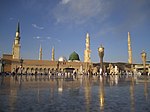|
Al-Hannanah Mosque
Al-Hannanah Mosque (Arabic: مَسْجِد ٱلْحَنَّانَة, romanized: Masjid al-Ḥannānah) is a Shi'ite mosque in Najaf, Iraq. This mosque is also called Masjid ar-Raʾs (Arabic: مَسْجِد ٱلرَّأْس), meaning "Mosque of the Head" (of Husayn ibn Ali), because Husain's head was kept in its middle, while being taken to his opponent Ubayd Allah ibn Ziyad, according to a hadith (narration) attributed to his descendant, Ja'far al-Sadiq.[1][2] SpecificationsThe Al-Hannanah Mosque is located in the metropolis of Najaf and Kufah, near the grave of Kumayl ibn Ziyad. It has an area of 7,400 square metres (80,000 sq ft).[3][4] According to Shaykh Al-Mufid, Sayyed Ibn Tawus and Shahid Awwal, when people arrived at the Al-Hannanah Mosque, they should recite two-unit prayers. HistoryJaafar Mahbouba believes that this mosque was built along with the Imam Ali Shrine. Al-Buraqi believed that this mosque was built by order of Abbas I of Persia, and due to this, he was known amongst the people of Najaf. According to Mohammad Hirz Eddin and Mirza Hadi el-Khurasani, Ghazan ibn Hulagu Khan ordered its construction.[2] According to a narration of Ja'far al-Sadiq, after Ali ibn Abi Talib died, his sons, Hasan and Husayn, carried his body from Kufa to Najaf. As they were passing, the pillars of the mosque inclined towards the body.[3][5] The name Al-Hannanah means "to cry twice." This refers to two events: first, when Ali's burial shroud was brought to the Mosque, and second, when the head of his son Husayn was brought through the Mosque.
See alsoReferences
External linksWikimedia Commons has media related to Al-Hannanah Mosque. |
||||||||||||||||||||||||||||||||||||||||||||||||||






